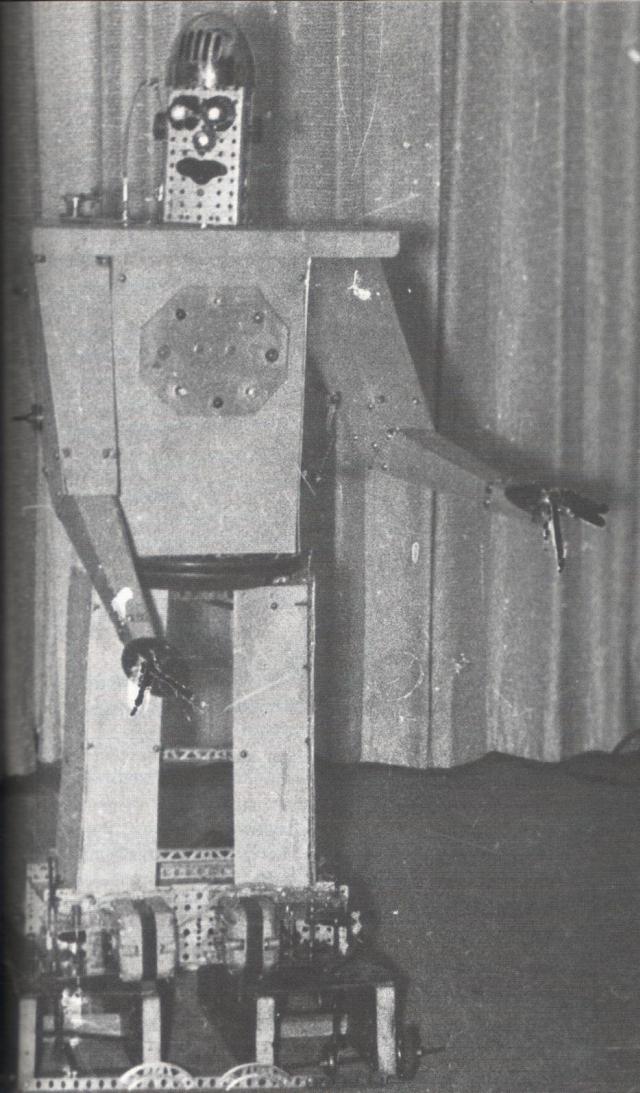
Michael Freeman's first robot was RUDY, a robot he designed and entered into the Westinghouse Science Fair in 1960, aged 13 where he won first place!. Rudy was a mechanical robot that could walk around by using a tether and wheels, and could remember where it went so that later on, it could re-trace its steps. Kind of like a mouse in a maze where it had rudimentary learning ability. Rudy was three-foot-tall with movable arms, a bullet-shaped head, light bulb eyes, and a wheeled platform for feet (and "named Rudy for the guy who used to clean the playground in front of my house"). He served drinks at cocktail parties. All you did was press a button on his back and he raised the drink tray toward you.
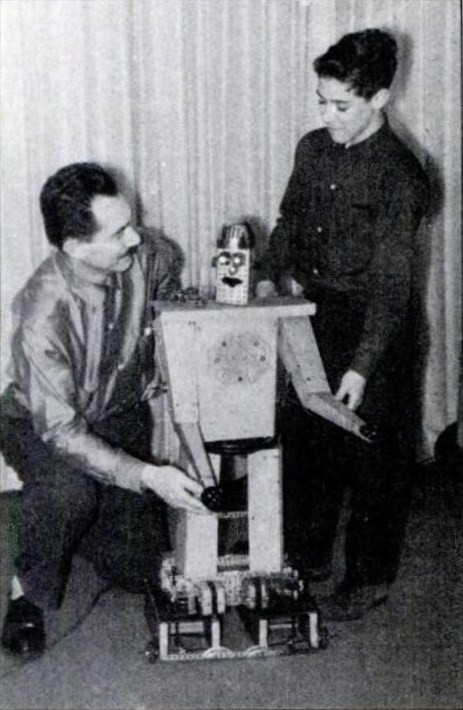
Michael Freeman went on to design and build very successful teaching and learning robots, starting with Leachim in the early 70's, then 2-XL, and Kasey the Kinderbot. See enthusiast Christopher Goodnough's World of 2-XL site for further information.
The Robots Are Coming By Douglas Colligan. New York Magazine 1978
…Ingenious robots abound in New York. They read to the blind, teach children the metric system, and even deliver the mail …
"I hava baad newzzz. Your BRAIN may have short-cirCUlted. You have answered A, the word HE, but the corRECT answer is B, the WORD I. I guess human people ENjoy talking about THEMselves." His (its?) words had a weird electronic lilt. He stood about a foot tall, had a squat, boxy little body of gray plastic, two concave silvery dents for eyes, and a row of four red plastic buttons running across his chest. Sticking out from where his stomach would be was the butt end of an eight-track cartridge. His name was 2-XL. and he was designed and built about eight years ago. I had just taken one of his mini-quizzes and failed.
2-XL is one of a number of ingenious robots currently in use in New York. You will find Kurzie at the Mid-Manhattan library. Chauncey works in the Citibank building on Park Avenue. Leachim is gone now, but there's hardly a toy store or department store in town that doesn't have one of his descendants in it. And the silent, nameless invention of Jonathan Kaplan is at home waiting for Kaplan to reprogram its circuits. They're all machines, robots if you please, and they're everywhere.
Building robots is something of an obsessional hobby for Michael Freeman, the brain behind 2-XL. Freeman, a self-taught computer buff and full-time professor of management at Baruch College of the City University of New York. sat at his desk, his robot before him. In his early thirties but still boyish-looking. Freeman ticked off the genealogy of his electronic toy. Before 2-XL, there was Little Leachim, who was preceded by big Leachim. But before all these, there was Rudy.
When Freeman was thirteen years old he built a three-foot-tall robot with movable arms, a bullet-shaped head, light bulb eyes, and a wheeled platform for feet (and "named Rudy for the guy who used to clean the playground in front of my house"). He served drinks at cocktail parties. All you did was press a button on his back and he raised the drink tray toward you. He thought of Rudy again years later when listening to his wife. Gail. complain about teaching the intellectual mix of students in her fourth-grade class in the Bronx.
To help her out. Freeman built her a teacher's aide. This was Leachim (an anagram of his first name), a six-foot-tall, 200-pound robot with blue bulb eyes, a red wooden torso, and plastic pipe arms and legs. Freeman used his own money, about $15,000, to finance it. He used parts from defunct RCA computers to build it and used the collective expertise of himself, his wife, and a Baruch College colleague, Gary Mulkowsky, to mold Leachim into an acceptable teacher.
Freeman recorded everything that Leachim would teach or say on three thirteen-inch platters called verbal discs. Into this "brain" he poured most of the contents of a children's encyclopedia, the Guinness Book of World Records. a dictionary, a thesaurus, and a series of textbooks. The robot also knew some basic Spanish, what the words in the Pledge of Allegiance meant, some rules of chess, and a few snappy jokes. Stored in a separate memory system were the scholastic records of each of its students, their names, weak and strong subjects, and their hobbies. Once Leachim was plugged into the wall, he was programmed to be able to dip into each memory system and so provide a customized lesson for each child.
The children communicated with Leachim by using a telephone dial on the robot's chest to give their identity numbers and then listened to his lesson by headphones. To answer quizzes they would push multiple-choice buttons or dial in number answers. Leachim communicated with them with his voice, actually Freeman's voice in the disc memory, electronically de-toned to sound robotlike.
Practically every class, two or three kids would gather in the back of the class at Leachim's mechanical feet to work on some of their drill lessons while his human colleague, Gail Freeman, taught in the front. During a typical teaching session a child who dialed in her number code would hear the robot chirp; "Hello, Susan. How are you? Let us begin our lesson." It would then scan its memory for questions she had gotten wrong last time and maybe ask them again or tell her to look up the answer in one of her books, giving her the specific page number.
As a teacher, Leachim had the kind of patience only a machine could exercise but Freeman also made sure to build a personality into his robot as well. He could be a prodding or encouraging teacher according to how a child was answering the questions Given a wrong answer. Leachim might say, "I don't believe you're paying attention. Try that again." To a child who seemed to be having trouble he might come up with "You're thinking so hard I can see smoke coming out of your ears." For a right answer, the robot might teach the student some new chess moves, talk about sports, or tell him a joke, the kind that would go over big on The Muppet Show. Sample: "Why are Saturday and Sunday the strongest days? (pause) Because all the rest are weak days (canned robot laughter)."
Leachim had the mental reach of a thirteen-year-old child and could adapt to most students between the ages of nine and thirteen. He was deliberately programmed to keep stretching the minds of the children. "He could teach a retarded kid just above his level, and yet he could also challenge a very bright student." says Freeman. "That's what is great about a machine like this- You push a button and the machine will be to complicated as you want." Amazingly, no one—school officials, teachers, union, parents-opposed having a robot teach fourth-graders. If anything, Freeman says, they were intrigued. And most of the kids seemed to take it for granted that having a robot teach their class was part of the New York City educational experience. "Nobody was afraid of it," recalls Freeman, still amazed. "And this was a six-foot robot."
Leachim taught for three years, from 1972 to 1975, before he was un-plugged. The experiment was successful, Freeman found, but also time consuming. When the machine broke or had to be programmed with information on new children, only he could make the adjustments.
In Leachim, Freeman saw the potential of an educational machine that could be mass-produced and used for routine work in schools everywhere. So he built a more compact version, Little Leachim. A large toy company. the Mego Corporation, has mass-produced a version of this, an electronic toy called 2-XL (to excel).
Basically a simplified version of Leachim, the little plastic robot is equipped with five square inches of circuitry that lets it pick the appropriate program stored on specially designed eight-track cartridges. It dispenses knowledge on everything from history to the metric system. The last Freeman knew, there were around 200,000 all over the country, all speaking with his pre-recorded robot voice. "Hundreds of kids are learning to do the metric system from me," he says, "which is very fulfilling." 2-XL turned out to be a big commercial success (it was one of the big sellers last Christmas). But Freeman's opportunity to fulfill his dream of the teaching robot may be elsewhere. He has been talking to the chancellor of New York City's Board of Education about the possibility of using 2-XL as a teaching tool in the public school system. He already has several educational tapes ready for the little gray machine and has others planned for the future.
See Freeman's Leachim design patent D237383 here  .
.
Jasia Reichardt included a page on Leachim in her book Robots: Fact, Fiction and Prediction.
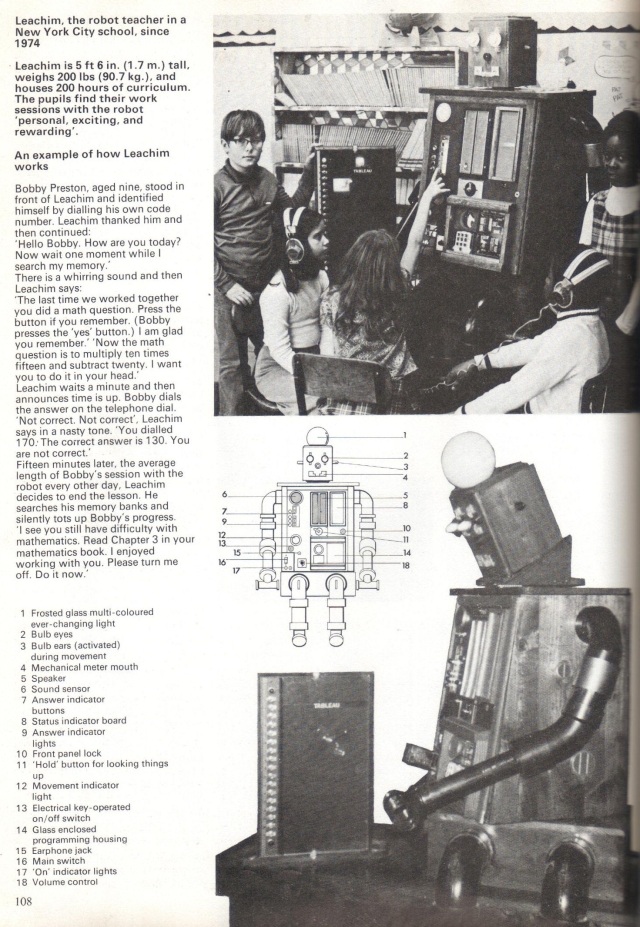
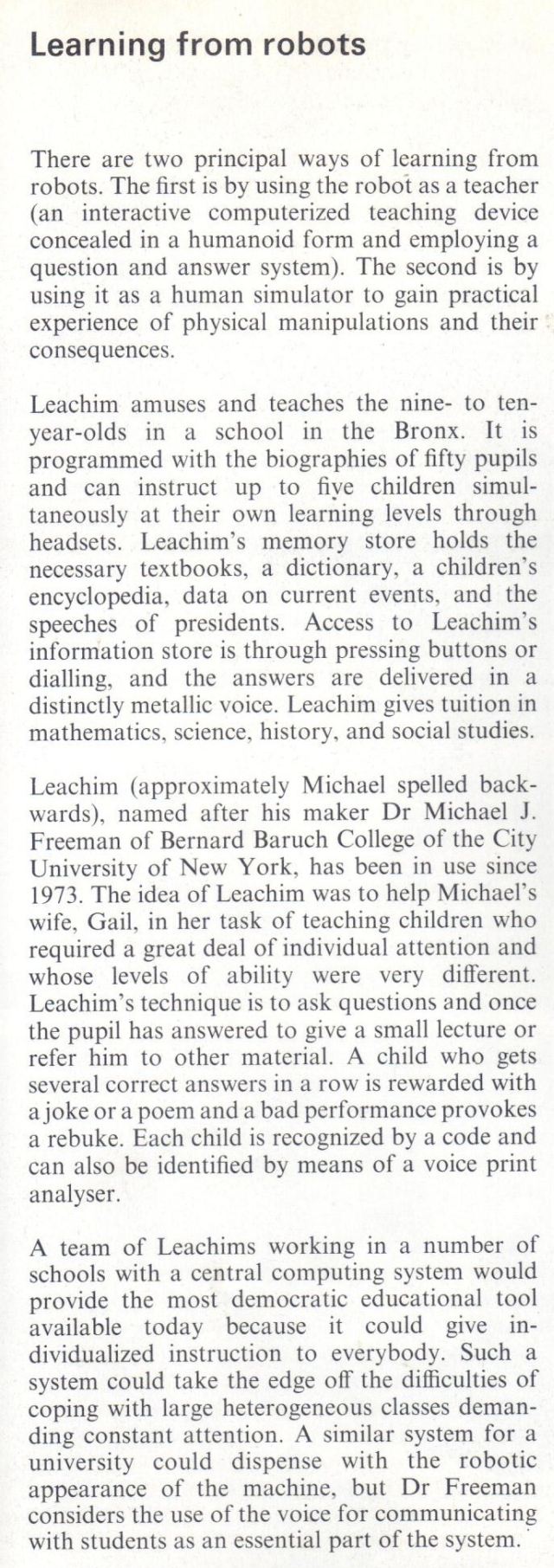
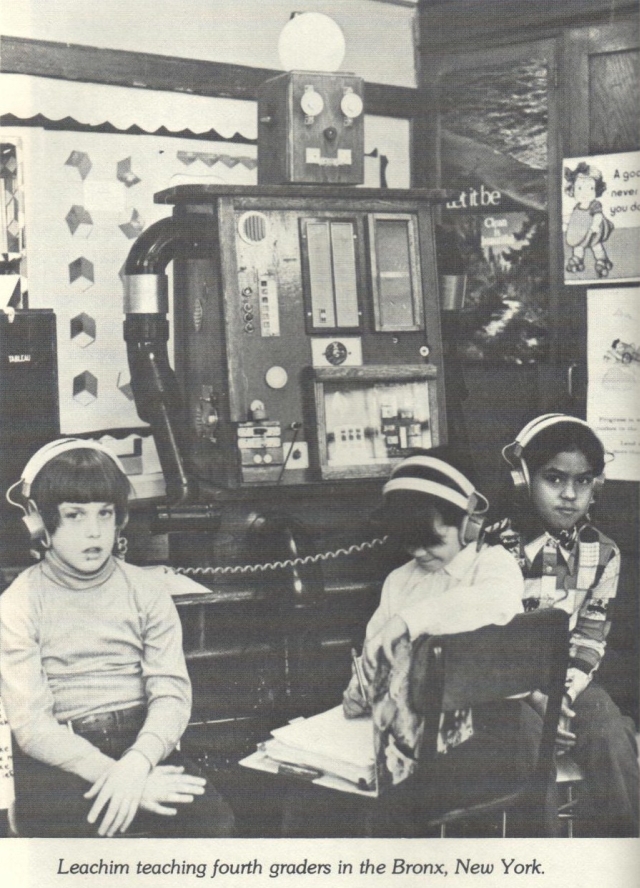
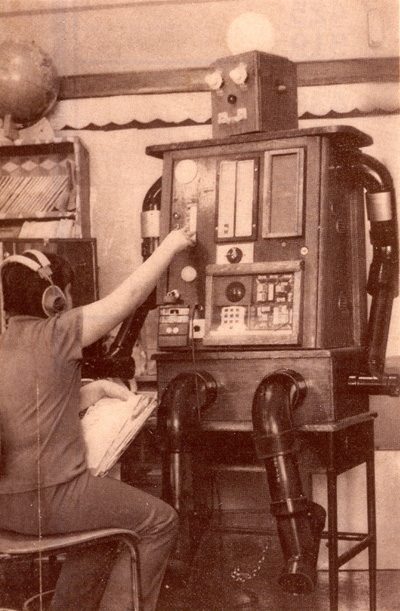
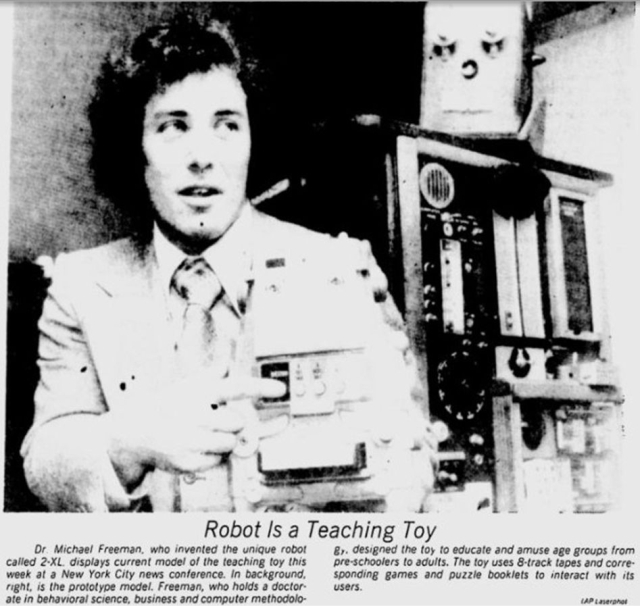
The Telegraph 25 May 1978.
Hi Jonathan,
I’ve corrected the OCR typos. I wasn’t aware that Leachim was stolen and not recovered. I can’t help you there.
Cheers, Reuben (cyberneticzoo.com)
The article on Leachim has a few proofing errors, which make some sentences nonsense.
It is also missing what I was looking for: the story of Leachim’s theft from the inventor’s car and how (or if) it was recovered.